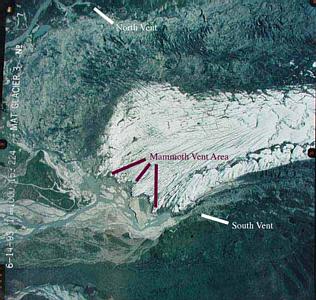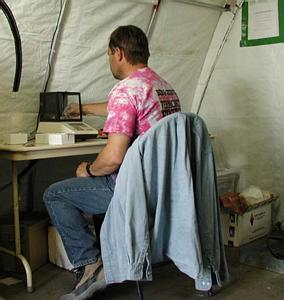7 July, 2000
July 7, 2000
Matanuska Glacier, Alaska
For the first time I woke to perfectly clear blue skies and the morning
air was much warmer than usual as a result. It looked like a perfect day
to get out on the glacier and begin work. However, the plans that Ben
and I had for the day had to be put on hold as we do not have access to
a working ISCO water sampler as yet. This is a critical piece of
equipment for what we will be trying to do in this project. Our time was
still put to good use helping with the tasks required in getting some of
the CRREL water samples filtered, dried and weighed.
During the past couple days we visited locations that will become very
familiar to us during this research - the moulins and vents of the
Matanuska Glacier. The vents occur at the terminus of the glacier and
there is a small number of them. Moulins however are all over this
glacier and all water running into them must eventually exit through
these vents. When you consider that this glacier is almost four miles
wide at its terminus and extends roughly 27 miles back into the Chugach
Mountains, there must be an awful lot of moulins around. What Ben and I
will be trying to do is determine what happens to water that flows into
a moulin. Is it possible that each moulin has its own path to its own
vent at the terminus? Obviously that cannot be the case as there are few
vents but many moulins. Perhaps several different moulins connect along
the way just like surface streams and rivers. Maybe they connect and
separate again, perhaps into even more branches than originally came
together. Could there be subglacial lakes that they dump into along the
way? Is there actually a water table at some depth in the ice just as
there is on land? How can this be determined when we cannot see under
the ice?
What we will be trying to do is answer some of these questions and more.
Perhaps what we find will raise still more questions. The method that we
will employ to try to find answers is called dye tracing. If a moulin
connects to a parcticular vent then if we dump a quantity of dye into the
moulin that dye should appear in the water rushing out of the vent. One
problem with the water coming out is that it is filled with very fine
parcticles of sediment and is extremely cloudy. How can we possibly see
the dye in such murky samples? And even if the water were free of
sediment, perhaps it would be too dilute to see by the time it comes
out. Imagine throwing a few packs of Kool-Aid into a stream and then
looking at the water downstream. We will use an instrument called a
fluorometer to detect and measure the amount of a special dye that we
will be using. It is very sensitive and can detect extremely small
amounts of this dye in a sample of water. I will go into more detail
about this instrument at a later date.
The dye we are using is rather expensive and so in the beginning we will
take a different approach. We donít want to waste dye if it does not
turn up at the vent we are sampling. As a result we will begin by
dumping rock salt solutions into the moulins. If the salt comes out the
vent we will detect its presence by noticing an increased conductivity
in the water sample. Absolutely pure water does not conduct electricity.
It is the presence of dissolved substances that allows water to conduct.
So what we hope to accomplish with the salt is connectivity - which
moulin dumps into which vent? This sounds simple enough and we hope it
is. We might miss completely and our salt may flow out of a vent other
than the one we sample from.Once we make connections we will then use
the dye for more detailed study of the flow. What we wonder right now is
whether or not the conductivity will rise enough to be detected. We hope
to find out soon. Till tomorrow.....
Marvin Giesting

In this aerial photograph you can see the location of most of the vents at the terminus. The dark area above and left of the white is part of the glacier too! It is ice that is covered by glacial debris and in many places even trees are growing. North is the topside of the picture. This photo was taken in 1993 and many things are a bit different now, but this is generally how it still looks from the air. You can see the parking area at the end of a loop toward the left.

Part of the day today I helped weigh filters and samples taken from the ISCO's. These sediment samples will be sent to the Cold Regions Research and Engineering Lab for later use by scientists studying sediment flow from the glacier. All work requiring electricity at our camp is coordinated to occur at the same time during the day to optimize the generator use.
Contact the TEA in the field at
.
If you cannot connect through your browser, copy the
TEA's e-mail address in the "To:" line of
your favorite e-mail package.
|
